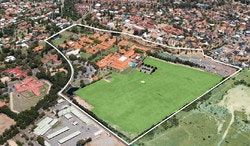Year 11 Mathematics Methods ATAR
This is an ATAR course which focuses on the use of calculus and statistical analysis. The study of calculus provides a basis for understanding rates of change in the physical world, and includes the use of functions, their derivatives and integrals, in modelling physical processes. The study of statistics develops students' ability to describe and analyse phenomena that involve uncertainty and variation.
Unit 1
This unit includes the following three topics: functions and graphs; trigonometric functions; and counting and probability.
The unit begins with a review of the basic algebraic concepts and techniques required for a successful introduction to the study of calculus. The basic trigonometric functions are then introduced. Simple relationships between variable quantities are reviewed, and these are used to introduce the key concepts of a function and its graph. The study of inferential statistics begins in this unit with a review of the fundamentals of probability and the introduction of the concepts of counting, conditional probability and independence. Access to technology to support the computational and graphical aspects of these topics is assumed.
Unit 2
This unit includes the following three topics: Exponential functions, Arithmetic and geometric sequences and series, Introduction to differential calculus.
The algebra section of this unit focuses on exponentials. Their graphs are examined and their applications in a wide range of settings are explored. Arithmetic and geometric sequences are introduced and their applications are studied. Rates and average rates of change are introduced, and this is followed by the key concept of the derivative as an 'instantaneous rate of change'. These concepts are reinforced numerically, by calculating difference quotients both geometrically as slopes of chords and tangents, and algebraically. Calculus is developed to study the derivatives of polynomial functions, with simple application of the derivative to curve sketching, the calculation of slopes and equations of tangents, the determination of instantaneous velocities and the solution of optimisation problems. The unit concludes with a brief consideration of anti-differentiation
Assessments
Assessment will include investigations: 20% | tests: 40% | examinations: 40%.
Reporting
A brief interim report on class work and behaviour will be issued towards the end of Term 1. The achievement for the course will be reported as a College A - E grade as well as a percentage mark for the course and an examination mark for both Semester 1 and the year. In addition, the student's approach to class work and behaviour will be reported via the usual key performance indicators.
Student Expectations
Students are expected to:
- bring the required text, calculator and stationery to each lesson
- complete regular homework from a variety of sources including the text, worksheets and MathsOnline
- be aware of assessment dates and have prepared thoroughly for each assessment
- be proactive in seeking help from the teacher when required.
